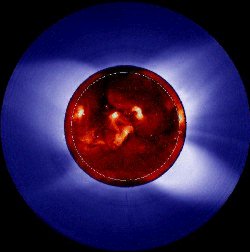Solar Missions
| Mission | Country | Launch Date | Mission End Date | Type | Mission Characteristics |
|---|---|---|---|---|---|
| Skylab | USA | May 14, 1973 | February 8,1974 | Manned orbiting spacecraft | Held the Apollo telescope mount (ATM) designed to study the Sun at various wavelengths Served as a solar observatory specializing in solar physics |
| Solar Maximum Mission | USA | February 14, 1980 | December 1989 | Orbiting spacecraft | Objective was to study solar actvity of solar cycle 21 which had peaked in late 1979 It carried 7 instruments designed to observe flares and associated phenomena in wavelength range from white-light to gamma rays |
| P78-1 | USA | 1979 | 1985 | Satellite | Objective was to study solar actvity of solar cycle 21 and 22 It made measurements of the broadening and shifting of x-ray lines at solar flare impulsive stages It carried the SOLWIND coronagraph and soft x-ray spectrometers |
| Spacelab 2 | USA | Summer 1985 | Mission lasted two weeks | Solar instruments housed in shuttle bay | Objective was to study ultraviolet and visible radiation from the Sun |
| Ulysses | USA/Europe | October 6, 1990 | December 2001 | Orbiting spacecraft | Is currently in high-latitude polar orbit around the Sun Mission objectives include examining the solar magnetic field, solar wind plasma and galactic cosmic rays |
| Yohkoh | USA/Japan | August 30, 1991 | ? | Satellite | Objective is to make high-energy observations of the Sun, focussing on flares and coronal disturbances |
| Geotail | USA | July 24, 1992 | After solar maximum, 2001 | Satellite | Objective is to understand the physics of solar-terrestial relations, particularly plasma interaction with the Earth's magnetotail |
| WIND | USA | November 1, 1994 | Currently active (7/97) | Satellite | Objective is to provide complete plasma, energetic particle and magnetic field input for magnetospheric/ionospheric studies Complements Ulysses mission in data gathered |
| Interball (Tail) | Russia and others | August 3, 1995 | ? | Satellite | Objective is to investigate solar-terrestial plasma interaction While located in the magnetospheric tail, the satellite will study the solar wind flux, ion composition, and electron flux |
| Spartan 201 | USA | September 8, 1995 | September 10, 1995 | Satellite | Shuttle launched and retrieved satellite whose mission was to study the Sun Payload consisted of two telescopes: the UV coronal spectrometer and the white light coronagraph |
| SOHO | USA/Europe | December 2, 1995 | Currently active (7/97) | Satellite | Objective is to investigate the Sun's corona, solar wind, and interior structure of the Sun Holds 12 instruments |
| Polar | USA | February 24, 1996 | Currently active (7/97) | Satellite | Objective is to measure solar plasma, energetic particles and magnetic field at high polar regions |
| Interball (Auroral) | Russia and others | August 29, 1996 | ? | Satellite | Objective is to investigate solar-terrestial plasma interaction
Satellite is located above the polar aurora |
| Advanced Composition Explorer (ACE) | USA | August 25, 1997 | ? | Satellite in L1 Halo orbit | The ACE spacecraft is sampling low-energy particles of solar origin and high-energy galactic particles. It also provides near-real-time reports of space weather. |
| Solar TErrestrial RElations Observatory (STEREO) | USA | October 25, 2006 | ? | Twin satellites in solar orbits | The pair of STEREO spacecraft are generating stereoscopic images and collecting 3D data about the Sun and CMEs. |
| Solar Dynamics Observatory (SDO) | USA | February 11, 2010 | ? | Satellite | SDO is capturing high resolution images and data about the magnetic field and brightness variation of the Sun. |
Last modified May 4, 2010 by Randy Russell.














